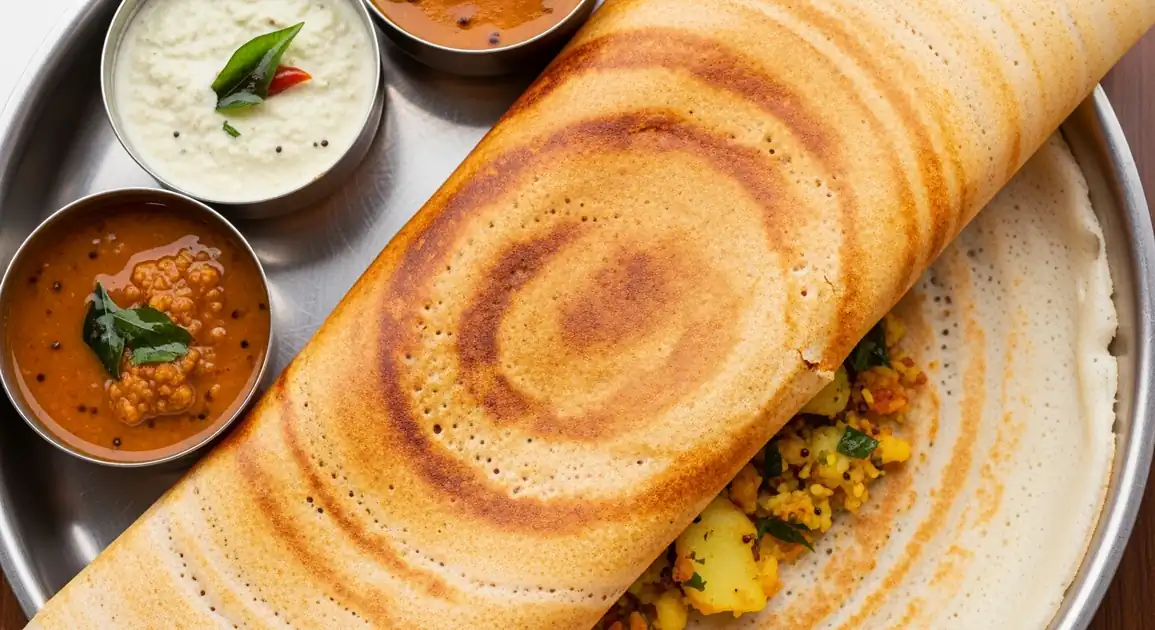Dosa
दोसा (Dosa)

Description
In Delhi, dosa has become a cherished culinary import from South India, adapted slightly to North Indian palates while maintaining its authentic essence. From upscale South Indian restaurants to street food stalls, dosas are widely available across the capital, often with the signature Delhi twist of slightly higher spice levels and occasionally more indulgent presentations.
Dietary Information
Serving information
Serving style
Typically served on stainless steel plates or thalis. Accompaniments (sambar and chutneys) come in small steel bowls. Some upscale places serve on banana leaves for authenticity.
Quick facts
Restaurants typically operate from 8 AM - 11 PM. Street vendors usually work from 10 AM - 10 PM, with some markets having different timings.
Safety Tips
What to Look For
-
Dosas cooked fresh to order on a clean, hot tawa (griddle)
Ensures proper cooking temperature that eliminates potential harmful bacteria. Fresh dosas have the best texture and taste.
-
Well-fermented batter (slightly tangy aroma)
Proper fermentation (8-24 hours) is crucial for both flavor and improved digestibility. It should have a pleasant sour smell, not overly pungent.
-
Clean storage of accompaniments (sambar and chutneys)
These should be kept in covered containers, with sambar kept hot and chutneys refrigerated when not in use.
-
High customer turnover
Popular places cycle through ingredients faster, ensuring freshness of batter and accompaniments.
-
Transparent kitchen or open cooking area
Allows you to observe hygiene practices and food handling.
What to avoid
-
Pre-made dosas stacked and waiting to be served
Dosas should be made fresh to order. Pre-made ones lose their crispiness and may be stored at unsafe temperatures.
-
Sambar or chutneys left uncovered or at room temperature for long periods
These accompaniments can spoil quickly and should be properly stored.
-
Reused oil with visible smoke or strong smell
Oil used for cooking should be clear and not smoking, as rancid oil affects both safety and taste.
-
Unclean serving plates or utensils
Check for properly cleaned dishes and utensils as basic hygiene indicator.
-
Watery or overly sour batter (sign of over-fermentation)
Over-fermented batter can indicate poor storage and may contain harmful bacteria.
Price information
Price range
Budget tips
- Street vendors in markets like Sarojini Nagar or Lajpat Nagar offer dosas for 50-100 INR.
- Some local 'dhabas' (small eateries) serve reasonably priced dosas (80-150 INR).
- South Indian restaurant chains like Saravana Bhavan or Sagar Ratna charge 150-300 INR depending on variety.
- Upscale hotels and restaurants may charge 250-400 INR for specialty dosas.
- Look for weekday lunch specials or 'thali' combinations for better value.
Value indicators
- Crispy texture with golden-brown color.
- Freshly prepared to order.
- Generous potato filling (for masala dosa).
- Flavorful, well-seasoned sambar.
- Multiple chutney varieties offered.
- Free sambar/chutney refills.
Where to Find This Dish
Connaught Place
Central hub with many South Indian restaurants, from budget to upscale.
Saravana Bhavan, Sagar Ratna, Naivedyam
Lunch, Dinner
South Delhi (Defence Colony, GK, Saket)
Upscale South Indian restaurants and food court options.
Select Citywalk Mall, Defence Colony Market
Lunch, Dinner
Karol Bagh
Mid-range and budget-friendly South Indian eateries.
Ajmal Khan Road, Bank Street
Morning, Evening
Janpath/Sarojini Nagar
Street food vendors and small eateries serving affordable dosas.
Sarojini Market, Janpath Market
Afternoon, Evening
Vendor Tips
- In Delhi, authentic South Indian chains like Saravana Bhavan or Sagar Ratna generally maintain high quality standards.
- Look for places where you can see dosas being made on the griddle.
- Restaurants with 'Madras', 'Udupi', or 'Chennai' in their names often specialize in authentic South Indian cuisine.
- Some Delhi vendors make spicier versions - specify if you prefer mild ('kam mirch').
How to Order
Regional Variations
-
Delhi-Style Masala Dosa
(दिल्ली स्टाइल मसाला डोसा)
Often has slightly spicier potato filling than South Indian versions, sometimes with added green chilies or garam masala.
-
Butter Dosa
(बटर डोसा)
A Delhi favorite featuring generous amounts of butter spread inside and outside the dosa, catering to North Indian preferences for richer flavors.
-
Paneer Dosa
(पनीर डोसा)
Contains cottage cheese filling, a Delhi adaptation incorporating this North Indian favorite ingredient.
-
Chinese Dosa
(चाइनीज़ डोसा)
Fusion variety featuring Chinese-inspired fillings with sauces like schezwan, popular in Delhi's street food scenes and representing the city's love for Indo-Chinese cuisine.
Cultural context
History
Dosa's origins trace back over 2,000 years to South India, particularly Tamil Nadu and Karnataka. Traditionally a breakfast item, it was created as a practical way to ferment rice and lentils for better digestion and nutrition. While authentic dosa remains true to its roots, its journey to North Indian cities like Delhi represents the beautiful culinary cross-pollination within India, adapting slightly to local tastes while maintaining its essential character.
Local significance
Dosa represents the successful integration of South Indian cuisine into Delhi's food culture, showing India's culinary diversity.
Eating customs
- In Delhi, people often use spoons more frequently than in South India.
- Mixing of sambar with rice (if ordered separately) is common.
- Dosas are sometimes ordered as shared appetizers before North Indian main courses.